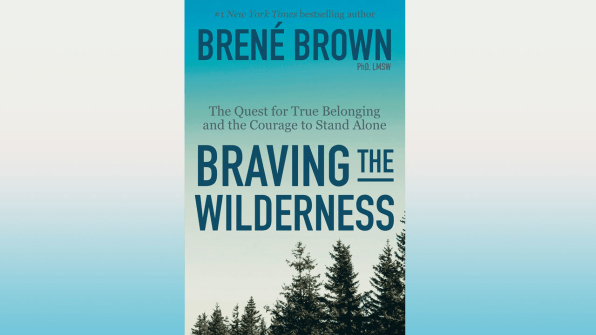Brené Brown: America’s Crisis Of Disconnection Runs Deeper Than Politics
For 20 years, I’ve taught at the University of Houston, the most racially and ethnically diverse research university in the United States. I recently asked my class of 60 graduate students whether their political, social, and cultural beliefs aligned with their grandparents’. About 15% of the students said yes or pretty close, while the remainder described everything from mild embarrassment to mortification when it came to their family members’ politics.
One African-American student said he saw eye to eye with his grandparents on just about every issue except the one that mattered most to him: He couldn’t come out to his grandfather even though the rest of his family knew he was gay. A retired pastor, his grandfather was “dug in” around homosexuality. A white student talked about her father’s habit of addressing waiters in Mexican restaurants with “hola, Pancho!” She had a Latino boyfriend and said it was humiliating. But when I asked these students whether they resented their grandparents or were willing to sever bonds with family members over political and social divides, the answer was no across the board.
You might think that the exhaustively documented polarization of American society would lead to more social interaction; if we’ve hunkered down, ideologically and geographically, with those we perceive to be just like us, doesn’t that mean we’ve surrounded ourselves with friends and people with whom we feel deeply connected? Shouldn’t “you’re either with us or against us” have led to closer ties among the like-minded?
In fact, the opposite is happening. At the same time that cultural and political sorting is on the rise, so is loneliness.
Hardwired For Connection, And Not Getting It
In his 2009 book The Big Sort: Why the Clustering of Like-Minded America Is Tearing Us Apart, the journalist Bill Bishop observed that in 1976, fewer than 25% of Americans lived in places where the presidential election was a landslide. In other words, we lived next door to, and attended school and worshiped with, people who held different beliefs than ours. We were ideologically diverse. In contrast, in 2016, 80% of U.S. counties gave either Donald Trump or Hillary Clinton a landslide victory. Most of us no longer even live near people who are all that different from us in terms of political and social beliefs.
This shift has tracked closely with another pattern over a similar time period. In 1980, approximately 20% of Americans reported feeling lonely. By 2010, according to AARP researchers, that figure had more than doubled. University of Chicago neuroscientist John Cacioppo defines the phenomenon as “perceived social isolation,” which basically means that we experience loneliness when we feel disconnected. Maybe we’ve been pushed to the outside of a group that we value, or we lack a sense of true belonging. At the heart of loneliness, Cacioppo believes, is an absence of meaningful social interaction–an intimate relationship, friendships, family gatherings, or even community or work group connections.
As members of a social species, we derive strength not from our rugged individualism but from our collective ability to plan, communicate, and work together. Our neural, hormonal, and genetic makeup support interdependence over independence. As Cacioppo explained in a 2013 TEDx Talk, the key to reaching adulthood “is not to become autonomous and solitary, it’s to become the one on whom others can depend. Whether we know it or not, our brain and biology have been shaped to favor this outcome.”
Cacioppo points out that biological machinery of our brains warns us when our ability to thrive and prosper is threatened. Hunger is a warning that our blood sugar is low and we need to eat. Thirst warns us that we need to drink to avoid dehydration. Pain alerts us to potential tissue damage. And loneliness tells us that we need social connection. He explains, “Denying you feel lonely makes no more sense than denying you feel hunger.”
Yet we do deny our loneliness. We feel shame around being lonely (as if feeling lonely means there’s something wrong with us), even when it’s caused by grief, loss, or heartbreak. This isn’t just sad–it’s actually dangerous. We’ve evolved to react to the feeling of being pushed to the social perimeter by going into self-preservation mode: when we feel isolated, disconnected, and lonely, we try to protect ourselves. That means less empathy, more defensiveness, more numbing, and less sleeping. In this state, the brain ramps up the stories we tell ourselves about what’s happening–narratives that often aren’t true and exaggerate our worst fears and insecurities.
If Fear Is How We Got Here, How Do We Get Out?
To combat loneliness, we must first learn how to identify it and to see that experience as a warning sign. Our response to that warning sign should be to find connection. That doesn’t necessarily mean joining a bunch of groups or checking in with dozens of friends. Numerous studies confirm that it’s not the quantity of friends but the quality of a few relationships that actually matter.
But if you’re anything like me, and you find yourself questioning the idea that starvation and loneliness are equally life-threatening, consider this 2015 meta-analysis of studies on loneliness, in which researchers found the following: Living with air pollution increases your odds of dying early by 5%. Living with obesity, 20%. Excessive drinking, 30%. And living with loneliness? It increases our odds of dying early by 45%.
No, there’s no evidence that sorting ourselves into politically distinct enclaves has made us lonelier; it’s not that simple. But one core variable driving that society-wide compulsion also happens to compound loneliness, and make it so life-threatening: Fear. Fear of vulnerability. Fear of getting hurt. Fear of the pain of disconnection. Fear of criticism and failure. Fear of conflict. Fear of not measuring up.
I started my research six months before 9/11, and I’ve watched fear change our families, organizations, and communities. Our national conversation is centered on, “What should we fear?” and, “Who should we blame?” I’m not an expert on terrorism, but after studying fear for 15 years, here’s what I can tell you: Terrorism is time-released fear. Its ultimate goal is to embed fear so deeply in the heart of a community that fear becomes a way of life. This unconscious way of living then fuels so much anger and blame that people start to turn on one another. Terrorism is most effective when we allow fear to take root in our culture. Then it’s only a matter of time before we become fractured, isolated, and driven by our perceptions of scarcity.
In a hardwired way, the initial trauma and devastation of violence unites human beings for a relatively short period of time. If during that initial period of unity we’re allowed to talk openly about our collective grief and fear–if we turn to one another in a vulnerable and loving way, while at the same time seeking justice and accountability–it can be the start to a very long healing process. If, however, what unites us is a combination of shared hatred and stifled fear that’s eventually expressed as blame, we’re in trouble.
If leaders race to serve up an ideological enemy to rally against, rather than methodically identifying the actual perpetrator, we’ll be emotionally distracted from the unraveling that’s really taking place in our homes and communities. When this happens, what feels like a rallying movement is really a cover for fear, which can then start spreading over the landscape. As fear hardens, it expands–becoming less of a protective barrier and more of a solidifying division. It forces its way down in the gaps and tears apart our social foundation, already weakened with those delicate cracks.

Our Bunkers Can’t Protect Us
In the U.S., our three greatest fault lines–cracks that have grown and deepened due to willful neglect and a collective lack of courage–are race, gender, and class. These are conversations that need to happen; this is discomfort that must be felt. Still, as much as it’s time to confront these and other issues, we have to acknowledge that our lack of tolerance for vulnerable, tough conversations is driving our self-sorting and disconnection.
Can we find our way back to ourselves and to each other, and still keep fighting for what we believe in? No and yes. No, not everyone will be able to do both, simply because some people will continue to believe that fighting for what they need means denying the humanity of others. That makes connecting outside our bunkers impossible.
I do believe, however, that most of us can build connection across difference and fight for our beliefs if we’re willing to listen and be vulnerable. But if we’re not even willing to try, the value of what we’re fighting for will be profoundly diminished. True belonging has no bunkers. We have to step out from behind the barricades of self-preservation and brave the wild. When we race to our customary defenses–of political belief, race, religion, you name it–we don’t have to worry about being vulnerable or brave or trusting. We just have to toe the party line.
Except doing that is not working. Ideological bunkers protect us from everything except loneliness and disconnection. Huddled behind them, we’re left unprotected from the worst heartbreaks of all.
This article is adapted with permission from Braving the Wilderness: The Quest for True Belonging and the Courage to Stand Alone by Brené Brown. Published by Random House, an imprint and division of Penguin Random House LLC, New York. Copyright © 2017 by Brené Brown. All rights reserved.
Fast Company , Read Full Story
(110)





